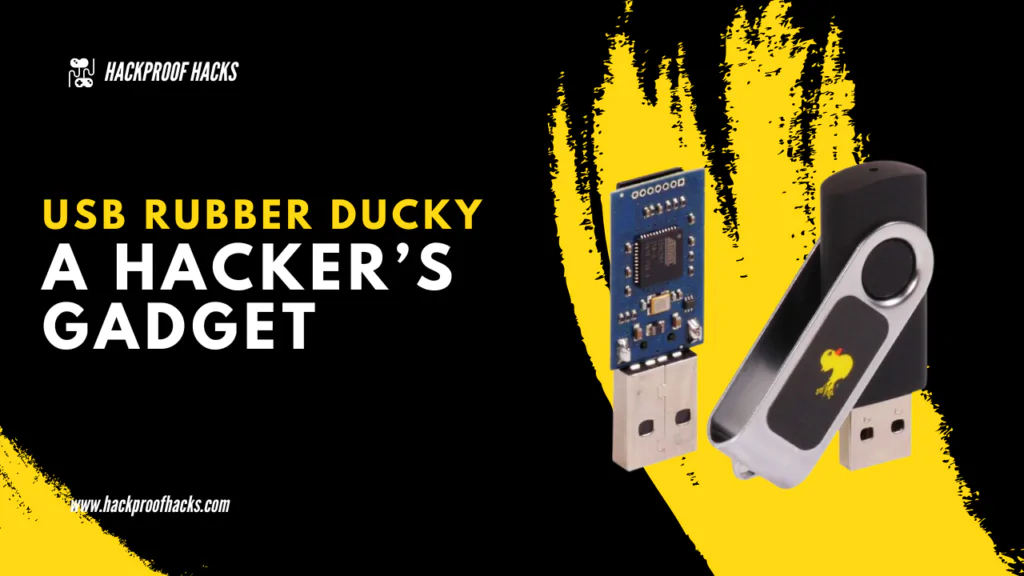
Hey there, curious reader! Have you ever heard of USB Rubber Ducky? It’s a nifty tool in the cybersecurity world that does some fascinating (and sometimes concerning) things. Imagine a USB drive that looks innocent but can act like a keyboard to sneak past security measures on a computer. That’s a USB Rubber Ducky for you!
Table of Contents
What is a USB Rubber Ducky?
The USB Rubber Ducky is a specialized tool utilized in cybersecurity for executing pre-programmed keystroke payloads on target computers. Unlike traditional USB drives, it resembles a regular flash drive but functions uniquely by emulating a keyboard, enabling it to bypass security measures.
You can purchase this device from here.
How Dangerous is USB Rubber Ducky?
Understanding the Threat Level
Now, let’s talk about the not-so-fun part. It can be pretty dangerous if misused. Hackers love it because they often leverage it to inject malicious keystrokes into a system, leading to unauthorized access, data theft, malware installation, or execution of harmful commands. Its ability to bypass security protocols makes it a potent tool in the wrong hands.
Potential Risks and Impact
The dangers associated with this device include the potential compromise of sensitive information, disruption of services, financial losses, and reputational damage for individuals or organizations. Its stealthy nature makes it challenging for traditional security defenses to detect or mitigate such attacks effectively.
Why Hackers Use USB Rubber Ducky?
Hackers prefer this device due to several advantages it offers for malicious activities. These include:
- Stealthy Execution: The device operates discreetly by mimicking human keyboard input, evading detection by security software or monitoring systems.
- Automation of Attacks: It allows hackers to automate attack sequences, saving time and effort while increasing the chances of success.
- Bypassing Security Measures: It can bypass security measures such as firewalls, antivirus software, and intrusion detection systems, granting unauthorized access to systems.
- Payload Customization: Hackers can customize payloads to perform a wide range of malicious actions, from stealing credentials to deploying ransomware.
How USB Rubber Ducky WorkS?
Technical Operation Overview
It functions by sending pre-configured keystrokes at high speed upon being plugged into a computer’s USB port. These keystrokes are designed to execute a sequence of commands or actions, such as opening programs, navigating menus, entering login credentials, or running scripts. The device emulates a keyboard, allowing it to interact with the target system as if controlled by a human user.
Payload Execution Process
The process of executing a payload using USB Rubber Ducky involves the following steps:
- Plug-in: This device can be physically plugged into the target computer’s USB port.
- Keystroke Injection: The device rapidly sends pre-programmed keystrokes to the operating system, bypassing security checks that would typically block direct external commands.
- Command Execution: The executed keystrokes trigger specific commands or actions on the target system, depending on the payload’s design and purpose.
- Stealthy Operation: The entire process occurs silently and swiftly, often without raising suspicion or triggering alerts on the target system.
How USB Rubber Ducky Can Be Used Ethically?
Ethical Applications and Best Practices
Despite its association with malicious activities, it can be used ethically in cybersecurity for the following purposes:
- Penetration Testing: Ethical hackers and cybersecurity professionals utilize this device to conduct penetration testing and security assessments. By simulating real-world attack scenarios, they identify vulnerabilities, test defenses, and recommend security improvements.
- Educational Training: USB Rubber Ducky serves as a valuable educational tool for learning about cybersecurity concepts, scripting languages, and defensive strategies. It provides hands-on experience in a controlled environment, helping individuals develop practical skills.
- Automating Routine Tasks: In non-intrusive scenarios, it can automate routine tasks, such as system configurations, software installations, or data backups. This enhances productivity and streamlines operational processes.
Ethical Guidelines and Responsible Use
To ensure ethical use of USB Rubber Ducky, it’s essential to adhere to the following guidelines:
- Obtain Proper Authorization: Always obtain explicit authorization before using USB Rubber Ducky for penetration testing or security assessments, ensuring compliance with legal and ethical standards.
- Use Safe Payloads: Create and use payloads that are safe, non-destructive, and designed solely for testing or educational purposes. Avoid payloads that may cause harm or disruption.
- Respect Privacy and Confidentiality: Exercise caution when conducting tests involving sensitive information. Respect privacy rights and confidentiality agreements, and obtain consent when necessary.
- Stay Informed: Keep abreast of cybersecurity best practices, legal requirements, and industry guidelines to ensure responsible and effective use of USB Rubber Ducky.
In conclusion, USB Rubber Ducky is a powerful tool with dual capabilities for both malicious and ethical use in cybersecurity. Understanding its potential risks, technical operation, and ethical guidelines is crucial for mitigating threats, promoting responsible usage, and enhancing overall cybersecurity resilience.




